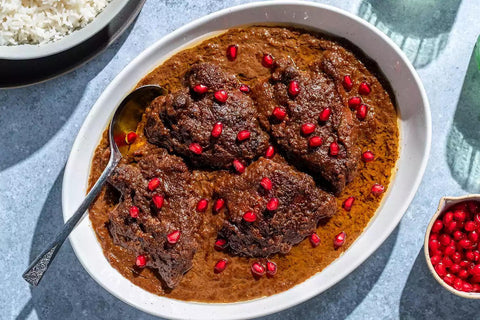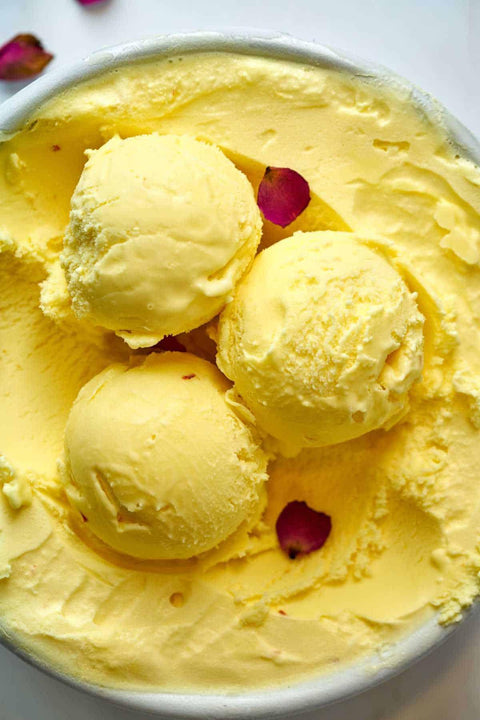Introduction:
Khoresh-e Fesenjoon is a popular Persian dish made with pomegranate molasses, ground walnuts, and meat. It has a unique sweet and sour taste and is usually served with steamed saffron rice. In this blog post, we will guide you through the steps to cook Khoresh-e Fesenjoon at home.
Ingredients:
- 1 lb boneless chicken or beef
- 2 cups of walnuts
- 2 onions, chopped
- 1 cup of pomegranate molasses
- 1 tbsp of sugar (optional)
- 2 tbsp of vegetable oil
- 1 tsp of turmeric
- Salt and pepper to taste
- Saffron (optional)
Instructions:
- Rinse the chicken or beef and cut it into small pieces. If using chicken, you can leave the skin on for added flavor.
- In a blender or food processor, grind the walnuts until they form a fine powder. You can also use a mortar and pestle to grind them.
- In a large pot, heat the vegetable oil over medium heat. Add the chopped onions and sauté until they become translucent.
- Add the turmeric to the pot and mix well with the onions.
- Add the chicken or beef to the pot and cook until it's browned on all sides.
- Pour the ground walnuts into the pot and mix well with the meat and onions.
- Add enough water to the pot to cover the meat and bring it to a boil. Once it's boiling, lower the heat to medium-low and let it simmer for about 45 minutes. Stir occasionally.
- After 45 minutes, add the pomegranate molasses to the pot and mix well. If you prefer a sweeter taste, add the sugar at this point as well.
- Let the Khoresh-e Fesenjoon simmer for another 30 minutes, stirring occasionally.
- If you are using saffron, soak a few strands in hot water for 10 minutes, then add them to the pot.
- Season with salt and pepper to taste.
- Serve the Khoresh-e Fesenjoon hot with steamed saffron rice.
 Image by New York Times
Image by New York Times
Conclusion:
Khoresh-e Fesenjoon is a delicious and hearty dish that is perfect for a family dinner or special occasion. With this recipe, you can make it easily at home and impress your friends and family with your cooking skills. We hope you enjoy making and eating this flavorful Persian dish!
What occasions Khoresh-e Fesenjoon is traditionally prepared?
Khoresh-e Fesenjoon is a popular dish in Persian cuisine and is often prepared for special occasions and celebrations. Here are some events where Khoresh-e Fesenjoon might be cooked:
- Weddings: Khoresh-e Fesenjoon is a popular dish served at Persian weddings, especially during the wedding reception dinner. It's a delicious and hearty dish that can feed a large number of people and is sure to impress the guests.
- Norooz: Norooz, or Persian New Year, is a 13-day celebration that starts on the spring equinox. Khoresh-e Fesenjoon is a traditional dish served during Norooz, along with other festive dishes.
- Family gatherings: Khoresh-e Fesenjoon is a dish that brings families together. It's often cooked for family gatherings, such as holidays or special occasions like birthdays or anniversaries.
- Religious events: Khoresh-e Fesenjoon is also a popular dish during religious events, such as Ramadan or the mourning period for Imam Hossein, a revered figure in Shia Islam.
In summary, Khoresh-e Fesenjoon is a dish that is cooked for various special occasions and events in Persian culture. It's a delicious and flavorful dish that is sure to impress and satisfy guests.

Image by: thespruceeats.com
What is the history and background of Khoresh-e Fesenjoon?
Khoresh-e Fesenjoon is a traditional Persian stew that has been enjoyed in Iran for centuries. Its origins are believed to date back to the ancient times of the Persian Empire. The dish is named after its two main ingredients, "fesenjān" meaning pomegranate paste and "fesenjān" meaning walnut.
The use of pomegranate and walnuts in Persian cuisine goes back to the Sassanid period (224 to 651 AD), where they were used to flavor and thicken stews. It is believed that Khoresh-e Fesenjoon evolved from these earlier stews and became popular in the northern regions of Iran, where the climate is more suitable for growing pomegranates and walnuts.
In addition to its unique flavor, Khoresh-e Fesenjoon has a special place in Persian culture and is often associated with special occasions and celebrations. It's a dish that is traditionally cooked by women for their families and loved ones, and it's considered a symbol of love and affection.
Over time, Khoresh-e Fesenjoon has evolved, and different variations of the dish have emerged. Some people use different meats, such as duck or lamb, instead of chicken or beef. Some people also add other ingredients, such as prunes or dried apricots, to the stew to add sweetness and complexity to the flavor.
Today, Khoresh-e Fesenjoon is a popular and beloved dish in Persian cuisine, and it's enjoyed by people all over the world. Its rich history and cultural significance have made it an important part of Iranian culinary heritage.



